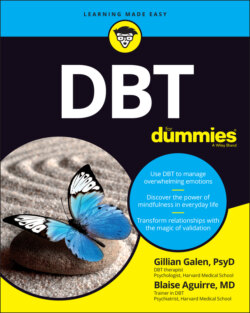Читать книгу DBT For Dummies - Gillian Galen - Страница 55
Moving from Impulsive to Spontaneous
ОглавлениеIN THIS CHAPTER
Comparing impulsivity and spontaneity
Moving past your initial reaction
Opening up to other possibilities
Changing negatives into positives
Impulsivity is one of the main reasons why people come into DBT treatment. It’s also one of the distinctive features of emotion dysregulation conditions such as borderline personality disorder (BPD). These impulsivity aspects of BPD encompass some of the most worrisome characteristics of the disorder, including suicidal behavior, self-injury, drug and alcohol misuse, dangerous sexual behavior, erratic driving, and difficulties in controlling anger. (See Chapter 2 for more information on emotion dysregulation.)
In DBT, we want you to move from impulsivity to spontaneity. In this chapter, you find out how to shift from impulsivity to spontaneity by moving past initial reactions, opening yourself up, and changing negative thoughts to positive ones. But first, we explain the differences between being impulsive and being spontaneous.
